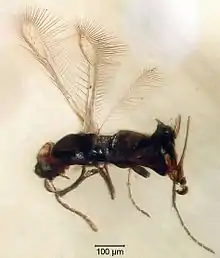The Cretaceous Portal IntroductionThe Cretaceous (IPA: /krɪˈteɪʃəs/ krih-TAY-shəs) is a geological period that lasted from about 145 to 66 million years ago (Mya). It is the third and final period of the Mesozoic Era, as well as the longest. At around 79 million years, it is the longest geological period of the entire Phanerozoic. The name is derived from the Latin creta, "chalk", which is abundant in the latter half of the period. It is usually abbreviated K, for its German translation Kreide. The Cretaceous was a period with a relatively warm climate, resulting in high eustatic sea levels that created numerous shallow inland seas. These oceans and seas were populated with now-extinct marine reptiles, ammonites, and rudists, while dinosaurs continued to dominate on land. The world was ice-free, and forests extended to the poles. During this time, new groups of mammals and birds appeared. During the Early Cretaceous, flowering plants appeared and began to rapidly diversify, becoming the dominant group of plants across the Earth by the end of the Cretaceous, coincident with the decline and extinction of previously widespread gymnosperm groups. (Full article...) Selected article on the Cretaceous world and its legaciesArtist's restoration of Nigersaurus taqueti. Nigersaurus was 9 m (30 ft) long, which is small for a sauropod, and had a short neck. It weighed around four tonnes, comparable to a modern elephant. Its skeleton was filled with air spaces connected to air sacs, but the limbs were robustly built. Its skull was very specialised for feeding, with a wide muzzle filled with more than 500 teeth. The jaws may have borne a keratinous sheath. Unlike other tetrapods, the tooth-bearing bones of its jaws were rotated transversely relative to the rest of the skull, so that all of its teeth were located far to the front. Nigersaurus was probably a browser, and fed with its head close to the ground. It lived in a riparian habitat, and its diet probably consisted of soft plants, such as ferns, horsetails, and angiosperms. It is one of the most common fossil vertebrates found in the area, and shared its habitat with other dinosaurian megaherbivores, as well as large theropods and crocodylomorphs. (see more...) Did you know? Fossil Myanmymar aresconoides specimen in amber.
Need help?Do you have a question about Cretaceous that you can't find the answer to? Consider asking it at the Wikipedia reference desk. Selected image
Selected article on the Cretaceous in human science, culture or economics Photograph of Edward Drinker Cope Cope had little formal scientific training, and he eschewed a teaching position for field work. He made regular trips to the American West prospecting in the 1870s and 1880s, often as a member of United States Geological Survey teams. A personal feud between Cope and paleontologist Othniel Charles Marsh led to a period of intense fossil-finding competition now known as the Bone Wars. Cope's financial fortunes soured after failed mining ventures in the 1880s. He experienced a resurgence in his career toward the end of his life before dying in 1897. Cope's scientific pursuits nearly bankrupted him, but his contributions helped to define the field of American paleontology. He was a prodigious writer, with 1,400 papers published over his lifetime, although his rivals would debate the accuracy of his rapidly published works. He discovered, described, and named more than 1,000 vertebrate species including hundreds of fishes and dozens of dinosaurs. His proposals on the origin of mammalian molars and for the gradual enlargement of mammalian species over geologic time ("Cope's Law") are notable among his theoretical contributions. (see more...) GeochronologyEpochs - Early Cretaceous - Late Cretaceous Landmasses - Baltica - Gondwana - Laurentia - Siberia Fossil sites - Beecher's Trilobite Bed - Walcott–Rust quarry Researchers - Charles Emerson Beecher - Charles Lapworth - Charles Doolittle Walcott Quality ContentFeatured Cretaceous articles - Bone Sharps, Cowboys, and Thunder Lizards - Bone Wars - Edward Drinker Cope - Geology of the Capitol Reef area - Geology of the Death Valley area -Geology of the Grand Canyon area - Geology of the Zion and Kolob canyons area Good Cretaceous articles - Chitinozoan - Coal ball - Dimetrodon - History of paleontology - Evolutionary history of life - Ornatifilum - Opabinia - Paleontology- Schinderhannes - Small shelly fauna - Temnospondyli - Tiktaalik - Waptia Subcategories Cretaceous Cretaceous by continent Cretaceous geochronology Cretaceous events Cretaceous geology Cretaceous life Cretaceous paleogeography Cretaceous stubs Things you can do
Current Cretaceous FACs - none currently Related contentAssociated WikimediaThe following Wikimedia Foundation sister projects provide more on this subject:
|

